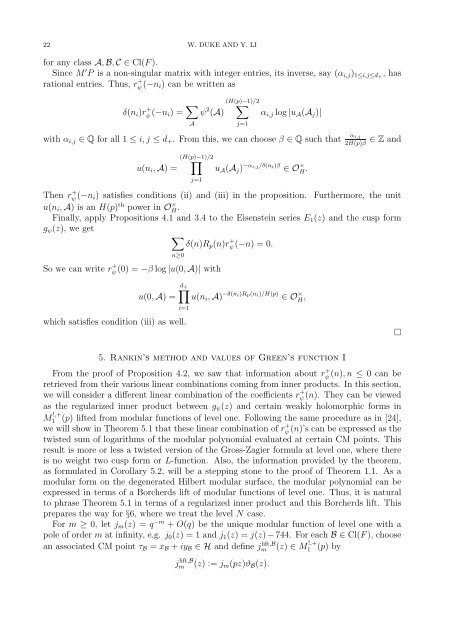Mock-modular forms of weight one - UCLA Department of Mathematics
Mock-modular forms of weight one - UCLA Department of Mathematics
Mock-modular forms of weight one - UCLA Department of Mathematics
Create successful ePaper yourself
Turn your PDF publications into a flip-book with our unique Google optimized e-Paper software.
22 W. DUKE AND Y. LI<br />
for any class A, B, C ∈ Cl(F ).<br />
Since M ′ P is a non-singular matrix with integer entries, its inverse, say (α i,j ) 1≤i,j≤d+ , has<br />
rational entries. Thus, r + ψ (−n i) can be written as<br />
δ(n i )r + ψ (−n i) = ∑ A<br />
(H(p)−1)/2<br />
∑<br />
ψ 2 (A) α i,j log |u A (A j )|<br />
j=1<br />
with α i,j ∈ Q for all 1 ≤ i, j ≤ d + . From this, we can choose β ∈ Q such that<br />
u(n i , A) =<br />
(H(p)−1)/2<br />
∏<br />
j=1<br />
u A (A j ) −α i,j/δ(n i )β ∈ O × H .<br />
α i,j<br />
2H(p)β ∈ Z and<br />
Then r + ψ (−n i) satisfies conditions (ii) and (iii) in the proposition. Furthermore, the unit<br />
u(n i , A) is an H(p) th power in O × H .<br />
Finally, apply Propositions 4.1 and 3.4 to the Eisenstein series E 1 (z) and the cusp form<br />
g ψ (z), we get<br />
∑<br />
δ(n)R p (n)r + ψ<br />
(−n) = 0.<br />
n≥0<br />
So we can write r + ψ<br />
(0) = −β log |u(0, A)| with<br />
u(0, A) =<br />
d +<br />
∏<br />
i=1<br />
which satisfies condition (iii) as well.<br />
u(n i , A) −δ(n i)R p(n i )/H(p) ∈ O × H ,<br />
□<br />
5. Rankin’s method and values <strong>of</strong> Green’s function I<br />
From the pro<strong>of</strong> <strong>of</strong> Proposition 4.2, we saw that information about r + ψ<br />
(n), n ≤ 0 can be<br />
retrieved from their various linear combinations coming from inner products. In this section,<br />
we will consider a different linear combination <strong>of</strong> the coefficients r + ψ<br />
(n). They can be viewed<br />
as the regularized inner product between g ψ (z) and certain weakly holomorphic <strong>forms</strong> in<br />
M !,+<br />
1 (p) lifted from <strong>modular</strong> functions <strong>of</strong> level <strong>one</strong>. Following the same procedure as in [24],<br />
we will show in Theorem 5.1 that these linear combination <strong>of</strong> r + ψ<br />
(n)’s can be expressed as the<br />
twisted sum <strong>of</strong> logarithms <strong>of</strong> the <strong>modular</strong> polynomial evaluated at certain CM points. This<br />
result is more or less a twisted version <strong>of</strong> the Gross-Zagier formula at level <strong>one</strong>, where there<br />
is no <strong>weight</strong> two cusp form or L-function. Also, the information provided by the theorem,<br />
as formulated in Corollary 5.2, will be a stepping st<strong>one</strong> to the pro<strong>of</strong> <strong>of</strong> Theorem 1.1. As a<br />
<strong>modular</strong> form on the degenerated Hilbert <strong>modular</strong> surface, the <strong>modular</strong> polynomial can be<br />
expressed in terms <strong>of</strong> a Borcherds lift <strong>of</strong> <strong>modular</strong> functions <strong>of</strong> level <strong>one</strong>. Thus, it is natural<br />
to phrase Theorem 5.1 in terms <strong>of</strong> a regularized inner product and this Borcherds lift. This<br />
prepares the way for §6, where we treat the level N case.<br />
For m ≥ 0, let j m (z) = q −m + O(q) be the unique <strong>modular</strong> function <strong>of</strong> level <strong>one</strong> with a<br />
pole <strong>of</strong> order m at infinity, e.g. j 0 (z) = 1 and j 1 (z) = j(z) − 744. For each B ∈ Cl(F ), choose<br />
an associated CM point τ B = x B + iy B ∈ H and define j lift,B<br />
m (z) ∈ M !,+<br />
1 (p) by<br />
jm<br />
lift,B (z) := j m (pz)ϑ B (z).
















